A fine, simple fly line leader loop
by John Gray
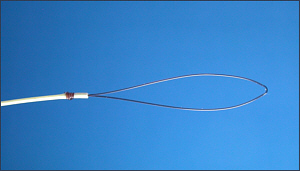
I have never liked
braided loops as a method of connecting my leader/cast to fly
line. For many years, I needle knotted a short length of
heavy monofilament to the end of the fly line, formed a
loop on the end of this butt section, and looped my
leader to it by way of a loop to loop connection. This
was, in my view, finer, simpler and more secure than the
kind of standard braided loop supplied ready made for
connection to fly lines. Yet it still seemed to me to
involve too many knots in the link between fly line and
fly, each of which might cause unnecessary disturbance
on the water surface. So I hit upon the idea of tying a
monofilament nylon loop directly to the end of the fly
line rather than on the end of the monofilament butt
section, thus shortening the connection and cutting out
one of the knots in the chain. For want of a more
imaginative name, I called it Gray's Loop.
Gray's Loop, then, is a
method of attaching a semi-permanent loop of nylon
monofilament to the end of a traditional PVC coated,
hollow braided core fly line to facilitate a loop to loop
connection with the leader. It is simple to tie, and the
resultant loop is very slim, secure and reliable. Such a
loop might last a whole season before needing replaced.
ATTACHING
LOOP TO FLY LINE
The tying procedure is
similar to that used for the Needle Knot or Nail Knot,
but with a doubled length of monofilament nylon. The
tying of Gray's Loop is illustrated in the series of
photographs shown below.
HOW TO
TIE GRAY'S LOOP
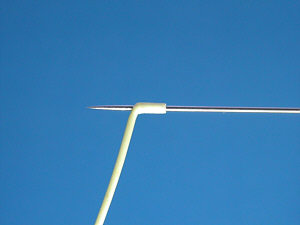
STEP ONE
Carefully insert a needle ( I have used
a size 7 long darner) into the centre of
the end of the fly line and out the side
wall of the fly line about half a
centimetre from the line tip. It is
important that the needle is pushed up
the centre of the internal braided core
of the fly line.
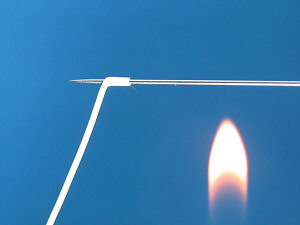
STEP TWO
Heat the needle with a lighter for a few
seconds to set the hole made by the
needle. This facilitates the threading
of the nylon monofilament through the
hole.
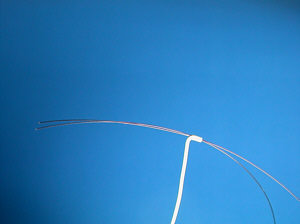
STEP THREE
Take an eighteen inch length (half a
metre) of suitable nylon monofilament,
double it and thread both ends through
the hole made in the fly line and out
the side wall. Cutting the ends of the
monofilament at a sharp angle makes it
easier to thread through the hole in the
fly line. See the table below for
suggested line/monofilament weights.
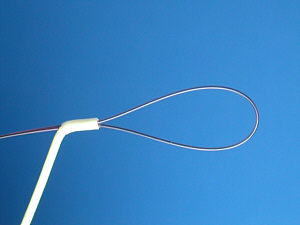
STEP FOUR
Pull the doubled monofilament through
until you have a loop of anything up to
an inch long. This will give a finished
loop of around two inches. If you want a
smaller loop of around an inch long,
start with as small a loop as possible
at this stage. A paperclip threaded onto
the loop will prevent it from slipping
through the end of the fly line and aid
the formation of a small loop. A loop as
short as one inch in length is fairly
easy to achieve if desired.
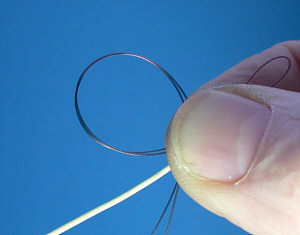
STEP FIVE
Form a loop in the doubled monofilament
and grip firmly between the thumb and
forefinger of the right hand (see the
main Fishing Knots page).
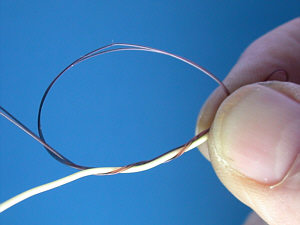
STEP SIX
Keeping a firm grip on the line and loop
with the right hand, use the left hand
to bring the two ends of the
monofilament through the loop (and round
the fly line) two or three times, any more
than three making the knot more bulky.
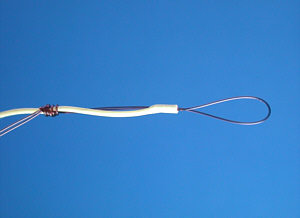
STEP SEVEN
Carefully draw the knot together so that
the turns of the knot are touching. Do
not over-tighten at this stage. The knot
must be slid along the line towards the
tip before tightening fully.
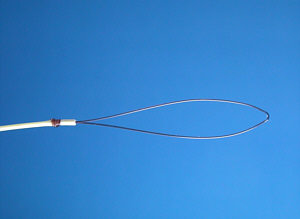
STEP EIGHT
Slowly slide the knot towards the tip of
the fly line, keeping the turns of the
knot together. When you have the knot in
place, with a finger of the right hand
in the loop and the left hand gripping
the two ends of monofilament, tighten by
pulling steadily until the knot grips
the fly line tightly. To test the
security of the knot, grip the fly line
in the left hand and, again with a
finger in the loop, pull steadily in
opposite directions. When satisfied,
trim the ends very close to the knot.
Though not essential, a coat of varnish
may be applied. |
Tying Tips
Starting
with a length of about 18 inches [half a metre] of nylon
makes it easier to pull the knot tight. Also, if you
want to create a small loop, start with as small a loop
as possible, using a paperclip on the loop to keep it
from slipping though the hole in the fly line:
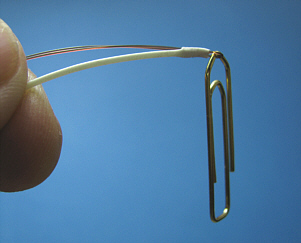
Loops of one to two inches in length are easily formed,
although a loop of anything up to around
three inches long works fine. The strength of the
nylon loop will vary with the weight of fly line and
breaking strain of leader. As a guide I use the
following :
|
FLY LINE # |
LEADER b.s. |
LOOP b.s. |
|
5 |
3 - 5 lbs |
10 lbs |
|
6 |
4 - 6 lbs |
12 lbs |
|
7 |
6 - 8 lbs |
12 lbs |
|
8 |
8 - 12 lbs |
15 lbs |
|
9 |
10 - 12 lbs |
15 lbs |
|
10 |
12 - 15 lbs |
18
lbs |
1 kilogram = 2.2 lbs
Gray's Loop

The Completed Loop
The
completed loop is fine, strong and durable.
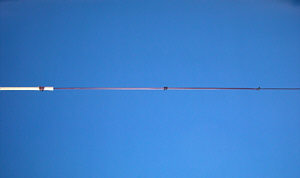
Gray's Loop and leader
Joined
by a loop-to-loop connection - the finest
loop-to-loop connection I know, resulting in a
minimum of surface disturbance.
This knot
is not suitable for fly lines with a kevlar or
monofilament core. The fly line must have a hollow
braided core, as in most traditional PVC fly lines. For
other useful fly fishing knots, see
FLY FISHING KNOTS.
These include the
Perfection Loop,
Water Knot and
Slip Knot
A QUICK GRAY'S LOOP
A much simplified, yet
serviceable, version of Grays Loop might be tied
to the end of the fly line by omitting steps one
to four above. Simply align the doubled length
of monofilament with the end of the fly line and
begin at step five, tying the loop on the end of
the fly line without first threading it through
the core of the fly line. Trim the end of the
fly line close to the knot. I have found this to
be generally secure and reliable, if not quite
as neat as the needle knotted version. This
simplified loop can be tied quickly on the
riverbank if need be. Again this knot is only
suitable for lines with a braided core.
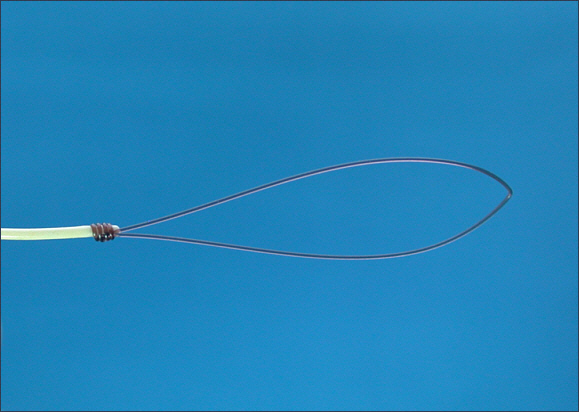
click to enlarge
|
|